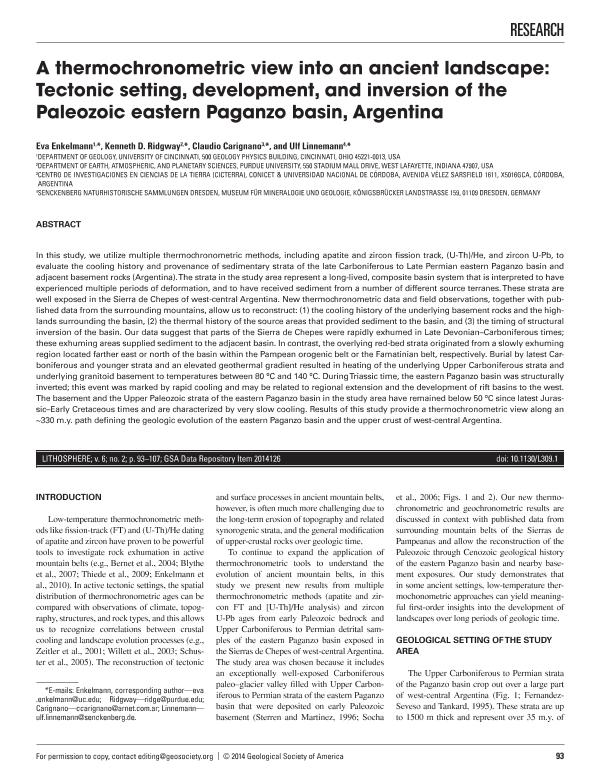Artículo
A thermochronometric view into an ancient landscape: Tectonic setting, development, and inversion of the Paleozoic eastern Paganzo basin, Argentina
Fecha de publicación:
04/2014
Editorial:
Geological Society of America
Revista:
Lithosphere
ISSN:
1941-8264
e-ISSN:
1947-4253
Idioma:
Inglés
Tipo de recurso:
Artículo publicado
Clasificación temática:
Resumen
In this study, we utilize multiple thermochronometric methods, including apatite and zircon fission track, (U-Th)/He, and zircon U-Pb, to evaluate the cooling history and provenance of sedimentary strata of the late Carboniferous to Late Permian eastern Paganzo basin and adjacent basement rocks (Argentina). The strata in the study area represent a long-lived, composite basin system that is interpreted to have experienced multiple periods of deformation, and to have received sediment from a number of different source terranes. These strata are well exposed in the Sierra de Chepes of west-central Argentina. New thermochronometric data and field observations, together with published data from the surrounding mountains, allow us to reconstruct: (1) the cooling history of the underlying basement rocks and the high-lands surrounding the basin, (2) the thermal history of the source areas that provided sediment to the basin, and (3) the timing of structural inversion of the basin. Our data suggest that parts of the Sierra de Chepes were rapidly exhumed in Late Devonian-Carboniferous times; these exhuming areas supplied sediment to the adjacent basin. In contrast, the overlying red-bed strata originated from a slowly exhuming region located farther east or north of the basin within the Pampean orogenic belt or the Famatinian belt, respectively. Burial by latest Carboniferous and younger strata and an elevated geothermal gradient resulted in heating of the underlying Upper Carboniferous strata and underlying granitoid basement to temperatures between 80 °C and 140 °C. During Triassic time, the eastern Paganzo basin was structurally inverted; this event was marked by rapid cooling and may be related to regional extension and the development of rift basins to the west. The basement and the Upper Paleozoic strata of the eastern Paganzo basin in the study area have remained below 50°C since latest Jurassic-Early Cretaceous times and are characterized by very slow cooling. Results of this study provide a thermochronometric view along an ~330 m.y. path defining the geologic evolution of the eastern Paganzo basin and the upper crust of west-central Argentina. © 2014 Geological Society of America.
Archivos asociados
Licencia
Identificadores
Colecciones
Articulos(CICTERRA)
Articulos de CENTRO DE INVEST.EN CS.DE LA TIERRA
Articulos de CENTRO DE INVEST.EN CS.DE LA TIERRA
Citación
Enkelmann, Eva; Ridgway, Kenneth D.; Carignano, Claudio Alejandro; Linnemann, Ulf; A thermochronometric view into an ancient landscape: Tectonic setting, development, and inversion of the Paleozoic eastern Paganzo basin, Argentina; Geological Society of America; Lithosphere; 6; 2; 4-2014; 93-107
Compartir
Altmétricas




